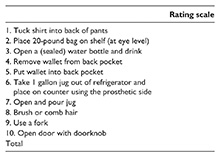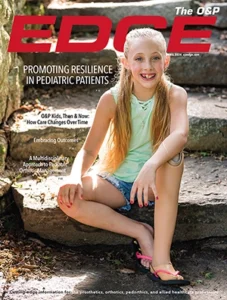In March 2013, a team of physical and occupational therapists published an outcomes measurement tool for adults with upper-limb amputations, the Activities Measure for Upper Limb Amputees (AM-ULA), to assess rehabilitation progress and document the effectiveness of prostheses. The efforts were predicated on prior research that revealed most outcome measures for patients with upper-limb loss were developed and used for pediatric patients, and that several that had been developed for adults did not assess activities, and most of those that had been developed for adults had been validated by able-bodied subjects rather than by those with limb loss. The work was led by Linda Resnik, PhD, PT, an associate professor (research) in the Department of Health Services, Policy and Practice in the Brown University School of Public Health, and a research career scientist at the Providence Veterans Affairs Medical Center, Rhode Island. Resnik and two colleagues have now developed and validated a briefer outcomes measure called the Brief Activity Measure for Upper Limb Amputees (BAM-ULA). The research article was published online January 16 in Prosthetics and Orthotics International (JPO).

Image of rating scale courtesy of the authors and JPO.
Whereas the AM-ULA comprises 18 measures, takes about 35 minutes to complete, and employs a scoring rubric requiring a clinician to make judgments about task completion, skillfulness of prosthesis use, movement quality, independence, and overall time to perform that activity, the BAM-ULA comprises ten measures, can be administered in about 11 minutes, and has a scoring system based on activity completion only. Thus, the BAM-ULA scoring does not require clinical judgment about magnitude of body compensation or awkwardness, and could potentially be administered by staff who may not be trained as physical or occupational therapists.
The ten items of the BAM-ULA are as follows: tuck a shirt in pants, lift a 20-lb. bag, open a water bottle, remove a wallet from a back pocket, replace the wallet in the back pocket, take a gallon of water from the refrigerator and place it on the counter (lift gallon jug), pour water from a gallon jug, brush or comb hair, use a fork, and open a door that has a knob.
In all, 35 people with upper-limb amputations were administered the BAM-ULA twice within one week. Internal consistency and test-retest reliability were evaluated. Construct validity was examined by comparing scores by amputation level. Concurrent validity was evaluated by examining correlations with other measures. Exploratory analyses using linear regression compared subgroup scores for users of myoelectric and body-powered devices, and, for users of single-degree-of-freedom and multiarticulating devices, controlling for amputation level.
The scale alpha was 0.83; intraclass correlation coefficient was 0.91. Item scores differed by amputation level and device type. Subjects with transradial amputations completed more items than those with amputations at the transhumeral or shoulder level. Users of myoelectric devices completed more items than users of body-powered devices. The BAM-ULA strongly correlated with the AM-ULA and three modified Jebsen-Taylor Hand Function Tests (JHFTs), and moderately correlated with one JHFS as well as with the Wong-Baker FACES Pain® Rating Scale. No differences in scores were found by degree of freedom of the terminal device after controlling for amputation level.
The article authors report that the analyses support reliability, construct validity, and concurrent validity of the BM-ULA. They observed a ceiling effect for the total score, with approximately 23 percent of subjects scoring within 1.9 points of the ceiling of the measure. This finding was driven by the prevalence of easier items which had very high completion rates, as well as the inclusion of a high proportion of subjects with transradial amputations (who on average completed 7.5/10 items). Given this finding, the authors suggest that the BAM-ULA may benefit from the addition of one or more items that are more difficult to complete and that this is an area where further research is needed.




